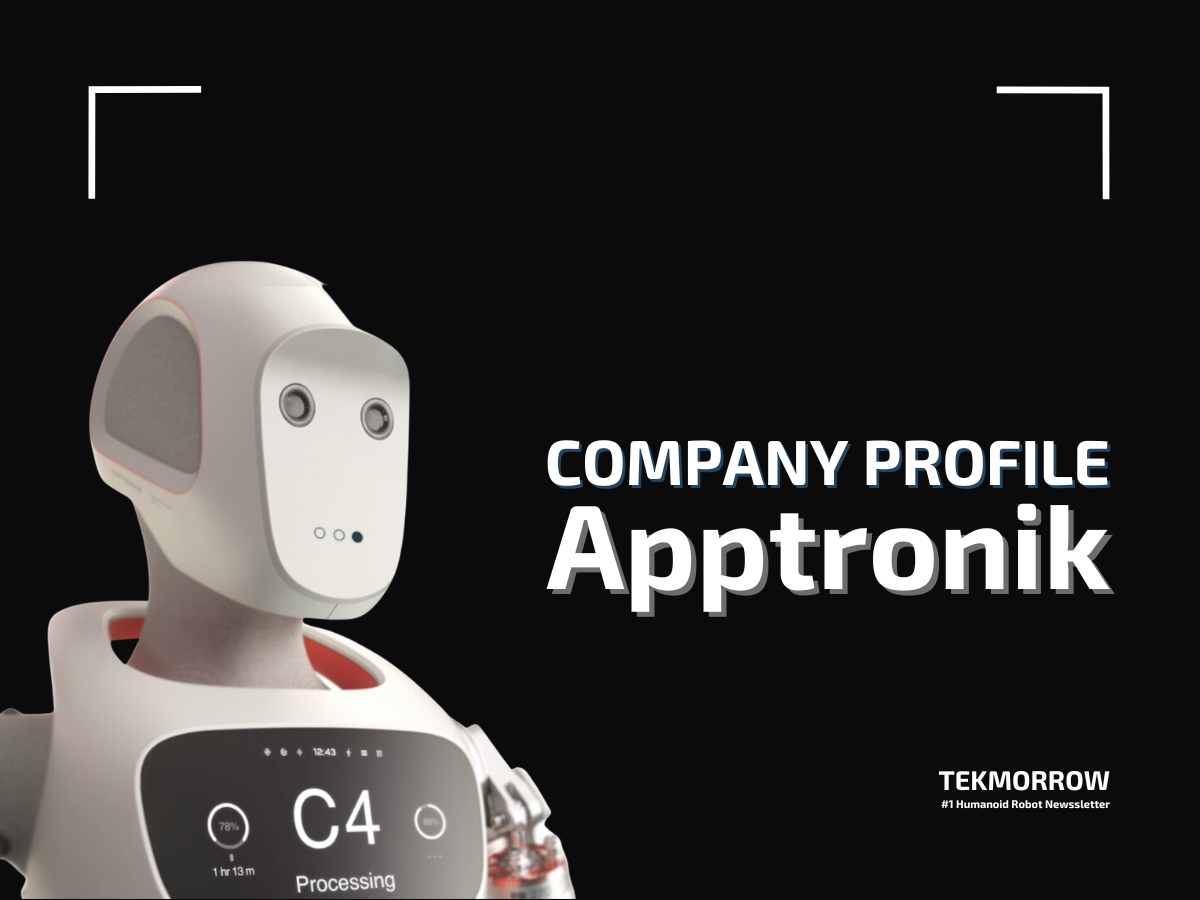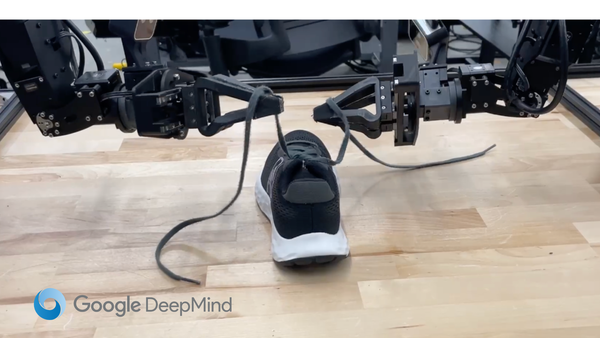Apptronik Company Profile and Analysis
Get a deep analysis of Apptronik, a robotics company. Learn how their Apollo humanoid robot is positioned for growth. Gain insights into their commercial strategy and the humanoid robot market.

Last Updated: July 2024
Apptronik Company Overview
Apptronik is a humanoid robotics company that started as a spinout of the Human Centered Robotics Lab at the University of Texas. Established in early 2016, the company focuses on developing advanced humanoid robots designed to work effectively alongside humans.
Apptronik's primary goal is to enhance productivity and safety across various industries by creating robots that can seamlessly collaborate with people.
Key Product: Apollo
Apptronik's flagship product, Apollo, is a versatile humanoid robot slated for commercial release by the end of 2024. Apollo can perform a variety of tasks in logistics, manufacturing, and retail settings. It is designed to address labor shortages and improve operational efficiency in multiple work environments.
Technology and Impact
Apptronik leverages cutting-edge technology to create robots that integrate with human operations. By doing so, they want to improve collaboration between humans and machines. Their efforts focus on practical applications of humanoid robots and ensure they can handle real-world tasks and challenges.
Future Outlook
Apptronik is positioning itself as a significant player in the humanoid robot market. Their innovative approach to robotics and dedication to improving human-robot collaboration indicate a promising future for the company and its products.
Apptronik Leadership Team
Apptronik's leadership team leverages expertise and domain knowledge to drive innovation and strengthen its strategic positioning. The team brings a wealth of domain and functional experience, contributing to the company's growth and success.

Key Members
Jeffrey Cardenas - Co-Founder and CEO
- Master's in Technology Commercialization and an undergraduate business degree from UT Austin.
- Specializes in product development and go-to-market strategy.
- Experience at Deloitte Consulting and multiple start-ups.
- Focuses on using technology to solve social issues.
Dr. Nicholas Paine - Co-Founder and CTO
- B.S., M.S., and Ph.D. in Electrical and Computer Engineering from UT Austin.
- Expertise in high-performance robotics actuators.
- Contributed to the NASA-JSC DARPA Robotics Challenge.
- Conducted postdoctoral research on cooling electric motors and embedded systems.
Kay Sheils - CFO
- B.S. in Economics from Duke University and an MBA from Stanford.
- Over 20 years of experience in institutional finance, focusing on disruptive technologies.
- Former CFO at Icon Technology and founding partner at CapStream Group.
- Held roles at Seaport Global, Morgan Stanley, and Jefferies.
Barry Phillips - CCO
- B.S. in Computer Science from the U.S. Naval Academy and a Master's in Computer Science from UCLA.
- Oversees Sales, Marketing, and Business Development.
- Held leadership roles at Fetch Robotics, Maxta, and Citrix Systems.
- Former U.S. Naval Aviation officer, P-3C Orion.
Greg Steele - Interim VP of Operations
- B.S. in Industrial Engineering from Oregon State University.
- Extensive operations experience in technology companies.
- Held senior roles at Vicarious, Enphase Energy, and Advanced Fibre Communications.
- Serves on the Board of Exchange Bank.
Apptronik's leadership team is composed of experienced professionals with diverse backgrounds.
Their functional expertise ensures that Apptronik continues to drive advancements in humanoid robotics and maintain its competitive edge.
Apptronik Product and Services: Apollo Humanoid Robot
Apollo, Apptronik’s advanced humanoid robot, is designed for environments including warehouses, manufacturing plants, retail spaces, and homes. Standing 5'8" tall and weighing 160 lbs, Apollo boasts a payload capacity of 55 lbs.

It features a four-hour runtime per battery pack, with hot-swappable batteries that ensure uninterrupted operation. This design allows Apollo to be highly adaptable and efficient in diverse settings, performing tasks within logistics and retail operations.
Versatile Applications
Apollo is designed to asset in jobs that are repeatable and monotonous. It is expected to pick and sort items in logistics and retail environments, potentially reducing the need for human intervention.
The robot is intended to support palletization, stacking and organizing goods on pallets for storage and transport, and assisting in unloading trailers, which could significantly reduce manual labor.
Apollo is being developed to support tote-based machine tending in manufacturing settings to ensure smooth production processes.
Additionally, it is planned to transport materials and products within industrial work cells to streamline workflow and enhance overall efficiency.
Human Interaction and Safety
Human interaction and safety are paramount in Apollo's design. It features LEDs on its head, mouth, and chest to communicate its status and interact with operators intuitively.
Apollo’s advanced force control architecture ensures safe movement around humans. At the same time, its adjustable perimeter zones and immediate pause functionality provide an extra layer of safety by detecting objects in its path. These features make Apollo a reliable and safe coworker in any environment.
Software Integration
Apollo’s software suite is designed for easy integration, allowing seamless deployment into existing warehouse and manufacturing operations. The intuitive software enables point-and-click control, simplifying task management and interaction.
This user-friendly interface ensures that Apollo can be incorporated into current workflows, enhancing automation without requiring extensive retraining or system overhauls.

Addressing Labor Market Challenges
Apollo's key focus is addressing labor market challenges. Taking on physically demanding and repetitive tasks reduces the need for human labor, which can help lower employee turnover and increase job satisfaction.
Apollo enhances operational efficiency by automating tasks, thus minimizing work-related injuries and reducing downtime. This could lead to substantial returns on investment by improving productivity and decreasing costs associated with turnover and injuries.
Technology and Innovation at Apptronik
Advanced Technologies Integrated Into Apollo
Apollo integrates advanced technologies to enhance its functionality. One of the key technologies is AI and machine learning.
In collaboration with NVIDIA’s Project GR00T, Apollo is learning new tasks from human demonstrations. This capability allows it to apply generalized skills like coordination and dexterity across various applications.
Apollo also employs state-of-the-art sensors and actuators. These include a unique force control architecture that mimics human muscle behavior using linear actuators. This setup ensures that Apollo can perform tasks safely around humans, providing an extra layer of security in its operations.
Additionally, Apollo’s modular design allows it to be mounted on various mobility platforms, offering flexibility for stationary and mobile operational needs.

Extensive R&D and Industry Collaborations
Apptronik’s commitment to innovation is evident through its extensive research and development efforts and industry collaborations. Apptronik has developed over ten robotic systems, including exoskeletons, industrial robotic arms, and bipedal mobility platforms. The development of Apollo integrates the best aspects of these previous projects.
Collaborating with industry leaders like NASA, Mercedes-Benz, NVIDIA, and GXO, Apptronik tests and refines its robots in real-world environments. These partnerships ensure that Apollo is not only technologically advanced but also practical and effective in various applications.
Patented Technologies Ensure Safety and Precision
Apptronik holds several patents for its innovative technologies, particularly in actuation and force control. The proprietary force control architecture is a standout feature, ensuring safe interactions between robots and humans.
This advanced technology allows Apollo to perform tasks with high precision and safety, setting it apart from other humanoid robots on the market.
Commitment to Continuous Innovation
Apptronik's dedication to continuous innovation and leveraging cutting-edge technologies positions it as a leader in the humanoid robot market. By augmenting human capabilities with advanced robotic solutions, Apptronik aims to transform industries and drive progress in robotics.
Funding and Financial Performance of Apptronik
Apptronik Secured Major Funding from Prominent Investors
Apptronik has demonstrated significant financial potential and garnered investor confidence through substantial funding. According to Crunchbase, the company has raised $28.7 million across multiple funding rounds, although other sources report the figure at $32.8 million.
In February 2023, Apptronik raised $13.9 million from Terex in a recent funding round. Earlier, seed round investors included notable firms such as Grit Ventures, Perot Jain, and Capital Factory.
This funding has been instrumental in supporting the development and commercialization of humanoid robots like Apollo, enhancing Apptronik's market presence and technological capabilities.
Financial Metrics and Ratios for Apptronik Are Not Publicly Available
While specific financial metrics and ratios for Apptronik are not publicly disclosed, the substantial funding and backing from prominent investors highlight the company's strong financial potential. This financial support enables Apptronik to attract top talent and establish key partnerships, underscoring its financial stability.
Additionally, continued investment in technology and market expansion reflects investor confidence in the company's growth potential. The consistent influx of capital indicates that stakeholders believe in Apptronik's ability to innovate and succeed in the competitive humanoid robot market.
Market Position and Commercial Strategy for Apptronik
Target Markets and Customer Segments
Apptronik targets industries that face labor challenges and have a high demand for automation. The company focuses primarily on third-party logistics (3PL), retail, and manufacturing sectors.
Apptronik provides versatile and adaptable robotic solutions that seamlessly integrate into existing workflows. These solutions address labor shortages, reduce turnover, and enhance operational efficiency. This approach helps these industries manage their operations more effectively and meet their labor needs with advanced technology.

Competitive Positioning
Apptronik leverages academic research and robotics expertise to establish a strong competitive position. They emphasize being a spinout from the Human Centered Robotics Lab at the University of Texas at Austin, a cutting-edge robotics research and robust technological innovations.
By positioning Apollo as the world’s most advanced humanoid robot designed for human-centric environments, Apptronik sets itself apart in the market, offering a unique blend of technology and practical application.
Marketing and Sales Strategies
Apptronik’s commercial strategy emphasizes Apollo’s transformative potential. Their website content highlights Apollo's ability to improve operational efficiency and safety across various industries.
They provide videos showcasing Apollo's versatility in performing tasks such as case picking, palletization, machine tending, and work cell delivery, Apptronik builds credibility and attracts customers.
The company also leverages strategic partnerships, discussed below, to enhance its market presence and drive customer interest.
Digital Marketing Performance
According to Semrush data, Apptronik has grown its digital marketing presence, with organic traffic increasing steadily to 3,164 monthly visitors since 2022. The number of organic keywords has risen to 410 during the same period, indicating a strong digital footprint.
With 76% of its website traffic originating from the United States, followed by Germany and Canada, Apptronik's brand recognition is evident. Notably, 90% of organic traffic comes from branded keywords, underscoring the company's strong brand identity and visibility.

Client Engagement in Business Development
Apptronik engages directly with clients through industry events, demonstrations, and collaborations. Maintaining a robust online presence with detailed product information on its website, the company supports its commercial efforts by providing comprehensive resources and showcasing real-world applications of Apollo.
This direct engagement helps Apptronik build strong relationships with potential clients and demonstrate the practical benefits of its humanoid robots.
RaaS as a Go-to-Market Strategy
Apptronik employs a Robotics-as-a-Service (RaaS) model as a strategic go-to-market approach. This subscription-based model lowers entry barriers by reducing the need for large upfront capital investments, making advanced robotics more accessible to a wider range of businesses.
It allows for scalable deployments, enabling businesses to adjust their robotic usage according to operational needs. The RaaS model includes ongoing upgrades, maintenance, and support services, ensuring optimal robot performance and minimizing downtime.
Additionally, it provides data-driven insights to help businesses optimize their processes and improve efficiency.
Strategic Partnerships and Collaborations
Apptronik's strategic partnerships and collaborations enhance its market position and technological advancements. The company partners with government projects and private sector organizations, including NASA for the DARPA Robotics Challenge, Mercedes-Benz, NVIDIA, and GXO.
These partnerships provide critical funding and resources, keeping Apptronik at the forefront of technological innovations. By focusing on quality, innovation, and strategic alliances, Apptronik capitalizes on the growing demand for humanoid robots across various industries and is positioned for continued growth and success.
Apptronik and GXO Logistics Partnership
Apptronik's and GXO Logistics signed a multi-phase R&D partnership to advance its humanoid strategy. GXO is conducting an early-stage proof-of-concept program to integrate humanoid robots into warehouse operations. This collaboration aims to leverage Apollo's capabilities to reduce repetitive work, improve safety, and allow employees to focus on higher-value tasks.
The companies are evaluating Apollo's performance in a lab setting to refine its AI model before deploying it to a U.S. distribution center. Apollo's design allows it to handle tasks ranging from transporting boxes to precise activities like picking items and scanning barcodes, representing essential steps toward scalable automation solutions.
Apptronik and NVIDIA Partnership
Apptronik collaborates with NVIDIA to enhance AI capabilities for its Apollo humanoid robot, advancing the field of general-purpose robotics. Apollo integrates with NVIDIA’s Project GR00T to quickly learn new tasks from human demonstrations, allowing it to tackle complex tasks by learning from text, video, and human interactions.
Utilizing NVIDIA Jetson AGX Orin and Jetson Orin NX modules, Apollo performs tasks efficiently and develops new skills rapidly. This collaboration aims to transform industrial workflows with real-world applications, enhancing productivity and efficiency.
Apptronik and Mercedes-Benz Partnership
Apptronik and Mercedes-Benz have entered a commercial agreement to pilot the Apollo humanoid robot in manufacturing facilities. Mercedes-Benz will explore applications for Apollo in logistics, such as delivering assembly kits and inspecting components.
Apollo will help optimize operations by delivering totes of kitted parts later in the manufacturing process. This partnership aims to fill labor gaps and enhance productivity in manufacturing, showcasing Apollo's versatile applications and expanding opportunities for advanced robotics in industrial settings.
Market and Competitive Analysis for Apptronik
Industry Trends and Market Dynamics
The humanoid robot market is poised for rapid growth, with mixed yet promising projections for the total available market (TAM). Significant adoption is anticipated across various sectors, including manufacturing, healthcare, education, hospitality, and retail.
Goldman Sachs projects the market to reach $38 billion by 2035, while Coherent Market Insights forecasts $46.31 billion by 2031. Grand View Research expects a compound annual growth rate (CAGR) of 21.1% from 2023 to 2030.
Key drivers of this growth include the rising demand across multiple sectors and advancements in artificial intelligence (AI) and robotics technology, which are enhancing the capabilities and versatility of humanoid robots.

SWOT Analysis
Apptronik showcases several strengths in technology and versatility, but it also faces cost and brand recognition challenges.
Strengths:
- Advanced Technology: Apollo utilizes cutting-edge technology, including collaboration with NVIDIA GR00T, which enables efficient task learning and execution from human demonstrations.
- Versatility: As a general-purpose humanoid robot, Apollo can perform tasks across multiple industries, increasing its market appeal and usability.
- Strong R&D Foundation: Originating from the University of Texas at Austin's Human-Centered Robotics Lab, Apollo benefits from a robust research background and extensive robotics development experience.
Weaknesses:
- High Costs: The development and production of advanced humanoid robots like Apollo are expensive, potentially limiting affordability and widespread adoption.
- Brand Recognition: As a relatively new company, Apptronik may face challenges in establishing its brand and gaining recognition compared to more established competitors.
- Manufacturing Scalability: Scaling up the production of complex humanoid robots to meet increasing demand can be challenging and may require significant investment and optimization of manufacturing processes.
Opportunities and Threats
Apptronik’s Apollo has several opportunities in manufacturing, logistics, and healthcare, but there are also competitive and regulatory threats to consider.
Opportunities:
- Growing Demand in Healthcare: The increasing elderly population presents significant opportunities for humanoid robots in caregiving and assistance roles, particularly in aging societies.
- Expansion into New Markets: Emerging markets and new applications in sectors like education, entertainment, and industrial automation offer substantial growth opportunities for Apptronik.
- Addressing Labor Shortages: Humanoid robots can help mitigate labor shortages by taking on physically demanding and repetitive tasks, improving efficiency, and allowing human workers to focus on more complex roles.
Threats:
- Intense Competition: The humanoid robot market is highly competitive, with major players like Tesla and Figure AI in the U.S., and prominent Chinese companies leading the industry.
- Regulatory Challenges: Compliance with varying industry regulations and standards for humanoids and AI can pose challenges, as regulations are still developing.
- Adoption Barriers: Businesses and consumers may be slow to adopt humanoid technology due to high costs, perceived complexity, and concerns about job displacement and safety.
Apptronik Competitor Analysis
Apptronik operates in a competitive landscape with several key players in the humanoid robot market. Major competitors include Agility Robotics, Tesla Optimus, Figure AI, and UBTECH Robotics, and 1X Technologies.
These companies have established themselves through continuous innovation, strategic partnerships, and substantial investments in R&D, positioning them as formidable contenders in the industry.

Apptronik Competitors
Agility Robotics: Digit
Agility Robotics' Digit is a versatile humanoid robot designed for diverse industrial environments, excelling in advanced technology and flexible applications. It operates effectively in warehouses and distribution centers, standing at 5'9" with a carrying capacity of 35 lbs.
Digit is designed to navigate spaces built for humans, handling bulk material and logistics tasks efficiently. Equipped with advanced perception and manipulation capabilities, it can perform complex tasks and adapt to various workflows, providing flexibility and enhanced productivity in industrial settings.
Tesla: Tesla Optimus
Tesla Optimus, also known as the Tesla Bot, is designed to perform repetitive and hazardous tasks in both household and industrial applications. Standing at 5'8" and weighing 160 lbs, it can carry up to 45 lbs.
Optimus operates on a 2.3 kWh battery pack, providing energy for a full day's work. Utilizing Tesla's Full Self-Driving (FSD) computer, it can execute autonomous tasks, focusing on dangerous, repetitive, or boring jobs to enhance safety and efficiency.
Figure AI: Figure 01
Figure AI's Figure 01 is a general-purpose humanoid robot designed to tackle labor shortages through task automation in human environments. It stands 5'6" tall, weighs 132 lbs, and can handle a payload of 44 lbs, with a runtime of 5 hours. Emphasizing autonomous learning,
Figure 01 can learn and perform tasks from human demonstrations independently. Its rapid development cycle enhances capabilities quickly, supported by partnerships like with OpenAI. Advanced in language processing and autonomous decision-making, Figure 01 is highly adaptable in various applications.
UBTECH Robotics: Walker X
UBTECH Robotics' Walker X is an advanced humanoid robot designed for household and office environments, featuring comprehensive sensory systems and AI integration. It stands 4.75 feet tall and weighs 170 lbs, making it suitable for indoor use.
Equipped with 36 high-performance servo joints, Walker X offers advanced motion capabilities. Its comprehensive sensory system includes force, vision, hearing, and spatial awareness, allowing it to navigate complex terrains and perform tasks with precise hand-eye coordination. Ensuring safe interaction with humans, Walker X integrates AI for smart home control and autonomous navigation, enhancing its adaptability and functionality.
1X Technologies: Eve
1X Technologies' Eve is an AI-driven humanoid robot designed for autonomous operation in diverse environments. Standing 6 feet 2 inches tall and weighing 192 lbs, Eve is designed for both domestic and industrial settings.
Eve focuses on providing advanced AI-driven interactions and efficient task execution, featuring safe human-robot interaction, robust autonomous navigation, and efficient task management. Eve aims to address labor shortages and enhance productivity across various settings, making it a versatile and powerful addition to the robotics market.
Regulatory and Compliance for Apptronik
As the field of AI and humanoid robots rapidly evolves, regulations and guidelines are still being developed and refined. Apptronik, like many companies in this sector, must navigate a complex landscape of existing and emerging standards to ensure the safety, privacy, and effectiveness of its products.
Adherence to Safety Standards
Apptronik must ensure that its robots, including the advanced humanoid robot Apollo, adhere to stringent safety standards. The design and operation of these robots should comply with ISO 13482 guidelines, which focus on safety requirements for personal care robots.
This compliance is essential for ensuring that Apptronik’s robots operate securely around humans, minimizing risks and promoting safe interaction. Apollo needs to undergo rigorous testing to ensure it does not harm users or the environment, adhering to industry safety norms and maintaining high standards of safety and reliability.
Compliance with Data Privacy and Security Regulations
Apptronik needs to protect user data and ensure compliance with data privacy regulations. The company must implement robust data protection measures to comply with the General Data Protection Regulation (GDPR) in Europe.
This includes maintaining strong cybersecurity protocols to safeguard sensitive personal data handled by its robots. Advanced security measures are necessary to protect user information from breaches and misuse, ensuring the integrity and confidentiality of the data managed by Apptronik’s systems.
Compliance with Regional Regulations
Apptronik must follow regional regulations to ensure its operations and products meet local requirements. In the United States, the company needs to adhere to regulations set by the Federal Trade Commission (FTC) for consumer protection and the Food and Drug Administration (FDA) for medical applications, even though Apollo is not currently know if Appollo is deployed in the healthcare market.
As Apptronik expands into the Asian market, it must align with regulatory frameworks in countries like Japan and South Korea, ensuring compliance with local standards and requirements.
Manufacturing and Logistics Compliance
In the manufacturing and logistics sectors, Apptronik must ensure that its robots comply with Occupational Safety and Health Administration (OSHA) guidelines.
This compliance is crucial for maintaining safe working environments in industrial applications. Apollo’s design needs to meet current standards and anticipate future needs, allowing for potential expansion into sectors such as elder care and household settings.
As the company explores these new applications, it must plan to meet relevant industry-specific standards to ensure safety and effectiveness in diverse environments.

Future Outlook for Apptronik
Growth Prospects and Expansion Plans
Apptronik is set for growth as it continues to advance the capabilities of its humanoid robots. The company is expanding its market reach by targeting a variety of industries, including logistics, manufacturing, construction, and healthcare.
These sectors are increasingly seeking automation solutions to enhance efficiency and address labor shortages, creating a robust demand for Apptronik’s innovative technologies.
Mass Production of Apollo
A key part of Apptronik's strategy is the mass production of Apollo, their flagship humanoid robot. By scaling up production, Apptronik aims to meet the rising demand for automation solutions in human-centric environments.
This approach ensures that businesses can adopt these advanced robots without the need for extensive and costly facility redesigns, making the transition to automation smoother and more accessible.
Meeting Demand for Automation
Apptronik is committed to ensuring that their automation solutions can be seamlessly integrated into existing operations. This focus allows industries to implement robotic technology without major disruptions to their current setups.
By offering versatile and adaptable robots like Apollo, Apptronik is well-positioned to address the growing need for efficient, human-friendly automation across various sectors.
Expanding Market Reach
The company’s expansion plans include targeting new markets and applications where humanoid robots can significantly enhance productivity and safety. By focusing on industries such as construction and healthcare, Apptronik is broadening its impact and opening up new avenues for growth.
This strategic expansion not only drives the company’s growth but also contributes to the broader adoption of humanoid robots in everyday operations.
Sources:
Apptronik and Mercedes-Benz Enter Commercial Agreement
Apptronik Collaborates with NVIDIA
GXO Advances Humanoid Strategy with Apptronik
Humanoid Robot Market Size, Share & Trends Analysis Report
Meet Apollo, the ‘iPhone’ of Humanoid Robots
Official PDF of the GDPR Regulation
Semrush Digital Marketing Data (Affiliate)
The Global Market for Humanoid Robots Could Reach $38 Billion by 2035
*The Semrush link in this article is an affiliate link. I receive a commission if you click the link and purchase Semrush. However, you're experience won't change.



